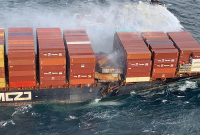Support strong Canadian climate journalism for 2025
Canada may have the longest total coastline in the world, but it still doesn’t have a solid understanding of the role nearshore ecosystems can play in sinking greenhouse gas emissions to combat the climate crisis, marine ecologist Julia Baum says.
“We're not really accounting for ocean climate solutions right now, which is ironic because we have three oceans.”
That will change with the launch of an ambitious research initiative to produce a national assessment of the “blue carbon” storage capacity of Canada’s salt marshes, seagrass meadows and kelp forests, said Baum, a principal investigator and University of Victoria professor.
The three-year, $1.59-million Blue Carbon Canada collaborative project involves an interdisciplinary team of researchers and policy experts from conservation agencies and federal agencies, including Parks Canada and Fisheries and Oceans Canada (DFO).
Salt marshes, eelgrass meadows, along with mangrove forests found in tropical countries, absorb carbon from the atmosphere and lock it in sediment at rates anywhere from two to 10 times greater than mature tropical forests, depending on a variety of geographic and environmental conditions.
Canada has promised to drop its emissions 40 to 45 per cent below 2005 levels by 2030. To meet its international climate commitments, it needs to leverage the nature-based solutions the ocean can offer, Baum said.
The project will determine where the country’s blue carbon ecosystems exist, estimate their mitigation capacity, and project how they might wax or wane under different climate change and protection scenarios.
The scientific information will help the federal government make informed climate policy decisions and determine conservation priorities, said UVic professor Hansi Singh, who is leading the research team’s climate scientists.

“By working directly with policymakers and conservation practitioners, our results will be readily translated into action,” Singh said in a press statement.
Blue carbon systems themselves, particularly kelp, are vulnerable to climate changes, Baum said, noting a series of recent marine heat waves badly impacted these marine forests. More research needs to be done to understand how much carbon they might capture or release during their life cycles, she said.
However, climate change is also warming northern waters, freeing them of ice and providing new habitat areas for fast-growing algae, she added. And Singh’s climate science team will help predict where emerging blue carbon ecosystems might occur in the future on Canada’s coastlines.
Information from the research will also help federal and provincial governments make decisions on where to have commercial fisheries or conservation areas, Baum said, citing Ottawa’s promise to protect 30 per cent of its oceans by 2030.
Government entities like Parks Canada or DFO are interested in knowing if there are co-benefits to these protected areas, she said.
“Can they benefit biodiversity and protect lots of species we care about and can they also provide carbon drawdown?” she asked.
“Right now, we don’t know the answer to that question.”
Rochelle Baker / Local Journalism Initiative / Canada’s National Observer







Comments
Ocean Acidification
The oceans absorb CO2 from the atmosphere, leading to ocean acidification, which threatens marine life.
Blue-carbon systems are vulnerable to acidification as well as climate change.
"Arctic Ocean acidifying up to 4 times faster than any other sea on Earth" (CP, Sept. 29, 2022)
https://www.ctvnews.ca/climate-and-environment/arctic-ocean-acidifying-…
See also the article ‘The Mediterranean Sea is so hot, it’s forming CO2 belching crystals.’ Truly terrifying. This process could counter any success in using shallow seas and coastal marshes to capture carbon.